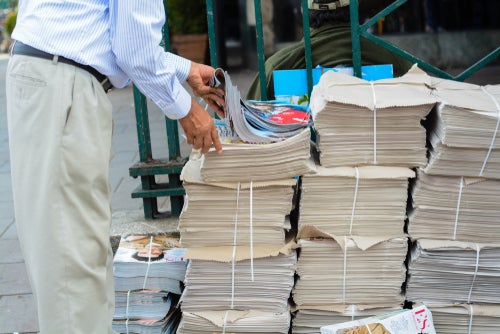
There has been a dramatic reduction in revenue, audience and staff sizes across the small independent (mainly local) UK media outlets monitored by the Public Interest News Foundation (PINF).
PINF estimates the UK’s 300 to 400 independent publishers make between £18.6m and £24.8m in annual revenue combined. The previous year’s estimate was £30m to £40m.
PINF monitors independent UK public news outlets with a turnover less than £2m.
On average, PINF found, website reach by unique users has more than halved and the number of employees has declined by a third.
The data comes from PINF’s fourth annual report assessing the state of independent local and regional news outlets. The report is based on a 48-question survey sent in January 2024 which received 73 responses.
[Last year’s report: Audience up but revenue still biggest challenge for independent news publishers]
Average independent publisher revenue falls by a third, with non-profits disproportionately impacted
The average revenue among independent local news publishers who responded to the survey this year is £62,000, which is down 30% from last year.
The fall was smaller among for-profits, who reported average revenue of £77,000 (down by 5%), while non-profits averaged £48,000 (down 50%).
Advertising now makes up 59% of revenue among surveyed publishers, the largest proportion of revenue it has accounted for since PINF started the survey four years ago.
PINF identified podcasting and email newsletters as having a positive impact on revenue.
"Correlational analysis of the data hints at routes to success in growing revenue," the authors wrote. "For the average non-profit, there is a positive correlation between revenue and each of Twitter/X followers, Threads followers, Instagram followers, podcast audiences, email subscribers.
"In the case of for-profits, there is no link between revenue and social media."
The 2024 PINF report includes a breakdown of average revenue and costs for four different types of publisher. The breakdown shows how most publishers are just breaking even or not at all, although the report's authors note the data was created using a small dataset.
Social media follower counts shrink but video views up
The report's authors suggested that "even allowing for significant overlap, it seems likely independent publishers are reaching most of the UK population". They reasoned this was true because there are between 300 and 400 independent publishers in the UK and their survey respondents reported an average annual online audience of 344,000 unique users (a fall of 56% compared to the previous year).
Facebook has replaced Twitter/X as the most used social media platform among respondents. The average publisher reports 10,000 Facebook followers, versus 9,000 on Twitter/X.
Although follower counts are down among respondents, they also reported an increase in social video views.
Formerly online-only publishers have started to invest in print, with 37% of publishers producing some print content last year.
Of all respondents, 71% focused on local news, 16% on regional, 8% on national, and 4% on global.
Whereas England has 85% of the UK population, it represents only 75% of the publishers sampled by PINF. Scotland has a larger share of the publishers (15%) than its share of the UK population (8%), as does Wales (7% against 3%). Northern Ireland accounts for both 3% of the publishers and the UK population.
The survey was not open to licensed broadcasters (including community radio stations) because of their distinct economic and regulatory environment.
Four in ten respondents (43% in 2024, 42% in 2023) were Impress-regulated while 13% were IPSO regulated, the same proportions as in 2023's report.
Expenditure cuts likely responsible for staff cuts
The average publisher has two full time equivalent employees, down from three last year, which the report's authors attributed to cost-driven cuts. Expenditure now averages at £56,000 across respondents, having decreased 38% since last year.
The last report included comments from publishers about the cost of living crisis and rising printing costs, with one survey respondent commenting "there is nothing left to cut."
The sector is estimated to employ 600-800 people, with a collective revenue between £18.5m and £24.8m.
When asked to rank how much they relied on volunteers, publishers gave an average of 53/100, with for-profits giving an average answer of 37/100.
Independent publishers consider themselves less impactful this year
There has been a growth in the percentage of women working in independent news publishing sector, at 34%. This compares to 22% in 2023.
Employees from ethnic minority groups occupied just 4% of roles despite accounting for approximately 18% of the English and Welsh population in the 2021 census. The 4% stat is unchanged from last year.
Publishers considered themselves to be less impactful this year, with the average independent publisher self-rating their impact at 62/100, compared to 68 last year.
The average non-profit reported its impact at 69, down from 72, while the average for-profit scored itself 55, down from 63.
PINF launches first Indie News Week to boost independent media
To coincide with the index's release PINF has announced it is launching its first Indie News Week, aiming to help publishers strengthen relationships with their communities. It will run from 3-9 June.
PINF will also run a match-funding campaign for public interest news, where raised money will be doubled by national donors.
The organisation says it is working with philanthropists to attempt to emulate the Press Forward initiative in the US, where major donors pledged half a billion dollars to rebuild local news.
PINF's executive director Jonathan Heawood said: "The UK can’t continue to rely on the efforts of professional journalists who are effectively subsidising the information needs of our society.
"At PINF, we are stepping up our efforts to strengthen capacity among indie news providers and to build external support for the sector."
Email pged@pressgazette.co.uk to point out mistakes, provide story tips or send in a letter for publication on our "Letters Page" blog
